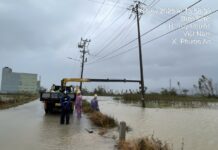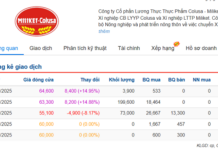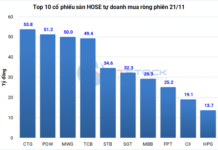
During the week, many new records were set for maximum capacity (Pmax) and daily electricity consumption
|
The Electricity Regulatory Authority (Ministry of Industry and Trade) reported that in week 17/2024 (from April 22 to April 28), due to the influence of the hot weather in all three regions, especially in the North, the demand for electricity was high, with an average daily output of 946.6 million kWh, 65.4 million kWh higher than the previous week (about 80.9 million kWh higher than the April plan). In the North alone, the average weekly load increased by more than 31.7 million kWh/day compared to the previous week.
Electricity consumption sets new records
In particular, during the week, many new records were set for maximum capacity (Pmax) and daily electricity consumption.
Specifically, at 1:30 p.m. on April 27, 2024, the national maximum capacity reached 47,670 MW; the national electricity consumption on April 26, 2024 reached 993.974 million kWh.
Compared to the same period in 2023, on days like April 26, the daily output of the national power system increased by 23.1%, the electricity output of the Northern power system increased by 35.5%; on April 27, the maximum capacity of the national power system increased by 20.2%, the maximum capacity of the Northern power system increased by 19.9%.
From the beginning of the year to date, the national load has increased by about 11.2% compared to the same period in 2023 (the North increased by 11.3%, the Central by 8.5%, the South by 11.7%).
Despite facing the situation of a high system load, with close monitoring and preparation, as well as flexible operation, the electricity supply in the last week continued to be well ensured.
The data on maximum capacity and daily electricity consumption showed a decreasing trend. Specifically, by April 29, 2024, Pmax had decreased to 41,601 MW, and daily electricity production had decreased to 879.360 million kWh. However, these figures are still high, especially compared to the same period in 2023.
Flexible operation and mobilization of power sources
During the week, the regulatory agency flexibly managed and saved water reservoirs in conjunction with solutions to change the grid transmission line connections to keep the reservoir water level at its maximum, ensuring efficient water intake for irrigation works, and at the same time ensuring water for electricity generation, especially during periods of high heat, ensuring electricity supply in 2024. The average daily mining output during the week reached about 174.6 million kWh.
For thermal power sources, the average daily output during the week was about 556.9 million kWh (36.1 million kWh higher than the April plan). All available thermal power units in the system have been mobilized. No unit is unavailable due to lack of coal. However, the total output lost due to incidents and capacity decline during the week was 318.25 million kWh and 95.98 million kWh, respectively.
The average daily mobilization of thermal power sources was about 91.1 million kWh (13.1 million kWh higher than the April plan). In week 17, the Phu My 2, Phu My 4, and BOT Phu My 3 units had to be mobilized to use LNG to increase the availability of resources and support the saving of hydropower in the North when the load increased due to the hot weather at the end of the week.
Renewable energy sources (excluding hydropower) were mobilized according to the announcement and the expected generation capacity based on the plant’s primary energy, taking into account the transmission constraints of the power grid and the absorption capacity of the system, with an average daily output of about 105.5 million kWh, of which wind power was 13.9 million kWh.
During the week, the transmission flow on the 500kV grid was still from the Central to the North and from the Central to the South. The heaviest transmission levels were on the 500kV lines Nho Quan – Nghi Son – Ha Tinh, Vinh Tan – Song May (95%), Vinh Tan – Tan Uyen (92%).

EVNHANOI strengthens the inspection of the grid corridor. Photo: EVN |
Persevere in implementing load balancing in all three regions
According to the forecast of the National Center for Hydro-Meteorological Forecasting, in the next 10 days, the heat may decrease in the evening, and rain, thunderstorms, etc. may occur in many places. The maximum capacity and demand for electricity may decrease, but we must not be subjective. We still need to closely monitor, flexibly manage, and strengthen electricity saving measures, and persevere in implementing the load balancing and regulation program to meet the peak capacity of the power system in all three regions of the North, Central, and South.
Accordingly, regarding the operation of power sources, for hydroelectric power, it will continue to be exploited according to the actual hydrological situation and the optimal regulation plan in the May 2024 operation plan, meeting the constraints of the power grid/system demand, water level, and downstream water supply requirements according to the inter-reservoir process; mobilizing thermal power plants according to the system demand, while ensuring the transmission capacity constraints of the power grid, system inertia, and voltage quality.
Mobilize gas turbine power plants according to the system demand, while ensuring the transmission capacity constraints of the power grid, voltage quality, and the safe and stable operation requirements of the gas fields according to the request of PV GAS.
Mobilize renewable energy to the maximum extent possible according to the primary fuel source, ensuring the safe, reliable, and stable operation of the power system, and not overloading the elements on the power system.
Mobilize oil-fired sources when necessary; create maximum conditions for testing new power plants.
The Electricity Regulatory Authority has also proposed solutions for operating power sources to ensure a safe and continuous electricity supply, especially during the 2024 dry season peak.
These include prioritizing hydropower water storage, preparing fuel (coal, oil, gas) for thermal power plants; completing the repair of units according to plan, and promptly fixing them. In particular, do not repair units in the North during the hot season from April to July. In case of abnormal hydrological developments towards the worse, allow the postponement of repair plans for coal-fired thermal power units to increase the availability of the power system.
The competent agency also requires the Electricity Corporations to make accurate forecasts of the peak load capacity, clearly announce the capacity to perform DR, and the capacity to mobilize the Diesel source of customers so that A0 can update the calculations for planning the operation.
The investors of power plants (especially coal-fired thermal power plants in the North) must ensure the readiness, reliability, and availability of the units and the entire plant, and avoid incidents during the peak months of the dry season; prepare sufficient fuel for electricity generation according to the mobilization needs of the system. This is a very important task, which is decisive for the ability to ensure a safe electricity supply during the peak months of the dry season because coal-fired thermal power is expected to account for ~52 – 60% of the total system output during the peak months of the dry season.
The National Power Transmission Corporation and the Electricity Corporations continue to review and ensure that the compensation equipment is ready in operation mode, ensuring the installed capacity; ensuring special discharge circuits, ensuring safe and reliable operation.
|
The Electricity Regulatory Authority requires power plants to increase reliability and availability, especially during the hot season; proposes to the Provincial People’s Committee and the Ministry of Natural Resources and Environment flexible regulations in the short term regarding the temperature of cooling water released into the environment during peak hot seasons (Mong Duong 1 & 2 power plants); increase spare parts for auxiliary |



































